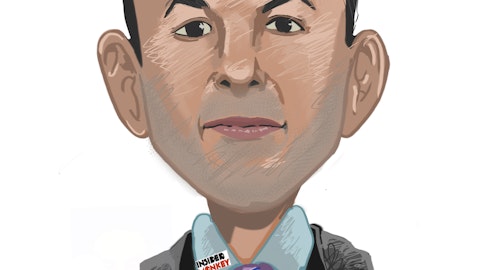Carl Lindner: Yes, Mike, good question. I think certainly, in workers’ comp, there continues to be some rate give up tied to positive results in that. I think it’s kind of a good news, bad news. The prior year excellent year for the industry and for us have turned out better generally over the last couple of years than what was expected. So I do think that is a factor. That said, I think in some of our comp businesses, we’re going to be growing in that. And our comp businesses continue to have excellent results. Our pricing guidance ex comp is 3% to 5%. And when you look at kind of the prospective loss ratio trends excluding comp, they’re right around 5%. So I think the — where we’re not quite getting to where we want to be on our rate increases or in some of the lines I just mentioned.
Public D&O is more competitive than what it should be. The higher excess liability business, particularly among Fortune 1000. I think as a business, we’re not going to get to the — to a prospective loss ratio trend. So I do think — I want to be careful because I do think that in our case, we’ve had really strong cumulative multiyear increases in our book, and we’re running in an 87% percent combined ratio this year. And some of our businesses are higher than that. Some of our businesses are better than that. And in our case, we look at each one of the businesses and what the strategy should be in each one. So anyhow, that would be my perspective on things.
Michael Zaremski: Okay. That’s helpful. I admit I’ll have to reread the transcript a bit on the good reinsurance renewal color. But I think I heard that retention went up materially. And if that is correct, should we be just thinking about anything in our models in terms of seasonality now or cat load or something?
Carl Lindner: I think what we’ve tried hard to do every year when we give guidance is to bake everything into our guidance. And I think we’ve tried to reflect that. I think one thing, in our case, I think retention went from 20 to 50, we probably should have been at 50 anyhow because when you look at the rate online, we had to pay and the amount of premiums that we had to pay for that lower layer, you could argue that we probably should have kept it anyhow. And that — so you have — it’s not $30 million of extra exposure, it’s really $30 million — I would guess, we probably paid $15 million or something like that. So it’s not really the full amount of the retention that really impacts us, if you understand what I’m saying.
Michael Zaremski: Okay. Yes, now that helps put it in context. Okay. And maybe I appreciate that there’s lots of different lines of business, but there’s been a lot of discussion on some of your competitors’ calls about loss trend maybe creeping up a bit for some, particularly not just on the property side, but a bit on the casualty side. Some have talked about the transportation segment that you guys have one of the most profitable transportation segments of publicly traded insurers. But any changes that you’d like to call out you’re seeing on the margins on loss trends?





